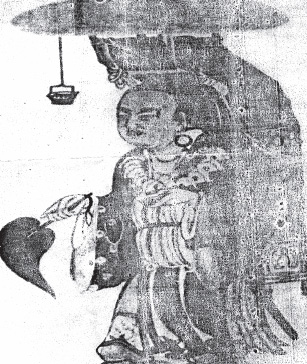A famous Chinese Scholar in Kashmir
by Mohan Kishen Tiku
A
famous Chinese pilgrim and scholar "Heun Tsiang" reached Kashmir from Urausha
(Hazara) now in Pakistan in about 631AD. He stayed here for more than two years
to study the Buddhist and Sanskrit lore. He travelled for more than sixteen
years (629-645 AD), through India and Central Asia. His reputation as a great
religious man and as a scholar preceded his actual entry in Kashmir.
Heuin Tsiang
had to face many hardships in the way to reach the desired place, which passed
through many rocky places.
When he was
about to enter the boundary of Kashmir, he was received with a great honour by
the king's maternal uncle, sent there in advance. The visiting dignitary was
provided with all necessary conveyances and a special horse from Royal stable.
While
proceeding towards the capital of Kashmir-he passed through several Buddhist
Monasteries, where he offered worship. He also spent a night at Hushkara Vihara.

Heun Tsiang
along with his party reached a place Dharmashala, which was just about 7 KM
from the city. The king of Kashmir was waiting at this place to receive Heun
Tsiang and his party personally and conducted him to the city. The city streets
were decorated with flowers etc; king's nobbles and Buddhist monks received him
near the entry of a monastery known as Jayandra-while seated on one of the
king's elephant. Next day after spending a night in the Monastery, the king took
him to his palace as special guest.
At the palace
the visiting dignitary was granted all possible comforts. The name of the king
who ruled the Kashmir during the visit of Heun Tsiang is not known from any
records till date. As per a Chinese text Varahamula (Modern Baramulla was
the capital of Kashmir those days. Heun Tsiang has recorded that Kashmir was
"a good agricultural country and produced abundant fruits and flowers etc. It
is also yielded horses. Saffron, Lenses and medicinal plants. The lenses were
probably Sanskrit Dahanopala-fire-stones burning gems. The crystal lenses. "The
climate is very cold in season with much snow and a little wind," "The people
wore serge and cotton. They were good looking. They were fond of learning and
have a faith". All facilities were extended to him so that he could fulfil
his mission to India and Kashmir in particular. Scores of Buddhist heads waited
for the Chinese royal guest. The king appointed more than twenty clerks for
copying out the Buddhist MSS under the direction of their head. In addition to
this, five more men were appointed to act as whole time attendants to the
visiting Chinese scholar. He was daily invited by the king to expound and read
Buddhist scriptures.
Heun Tsiang
remained in Kashmir for more than two years. During this period he devoted
himself to the study of selected sutras and sastras. He also
tendered his homage to Buddhist holy places in Kashmir. The Buddhist Monasteries
were about hundred in number, and there were above 5,000 Buddhist residences.
There were four Asoka Topes, each containing a portion of the bodly relics of
the Budha.
The Chinese
scholar has also put on record the tradition regarding the introduction of
Buddhism into Kashmir. There are many references in the literature of Buddhism
describing the beauty of the Kashmir Valley. King Ashoka while holding 3rd
Buddhist Council sent special invitation to the Buddhist Chiefs of Kashmir to
attend the country's council.
Heun Tsiang
records that during Ashoka's rule about 500 Arhals from Pataliputra migrated to
Kashmir. As per records left by the visiting Chinese scholar Emperor Kanishka
held his 4th Buddhist council in Kashmir. He further states that the work of
this Council was the composition of 100,000 stanzas of commentaries on each of
the three classics of canonical literature: a) Vinaya, b) Abhid harma, and c)
Sutra.
After his stay
Heun Tsiang left the Valley in 633 A.D. by way of T.Samidan route and reached
Pun-nu-tso, Modern Poonch.
*(The
writer is a journalist and presently lives at Mahinder Nagar, Jammu.)
Source: Kashmir
Sentinel
| 